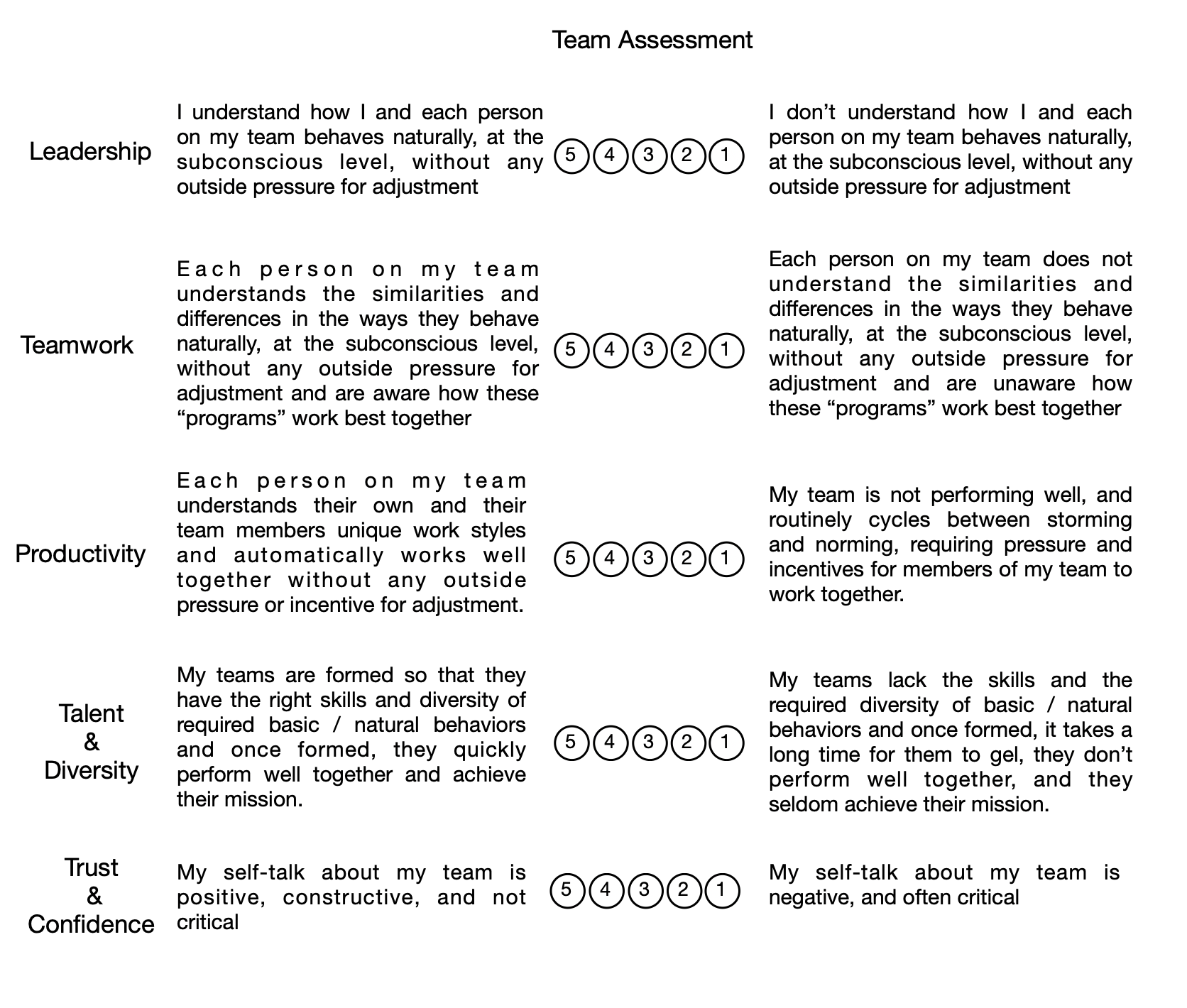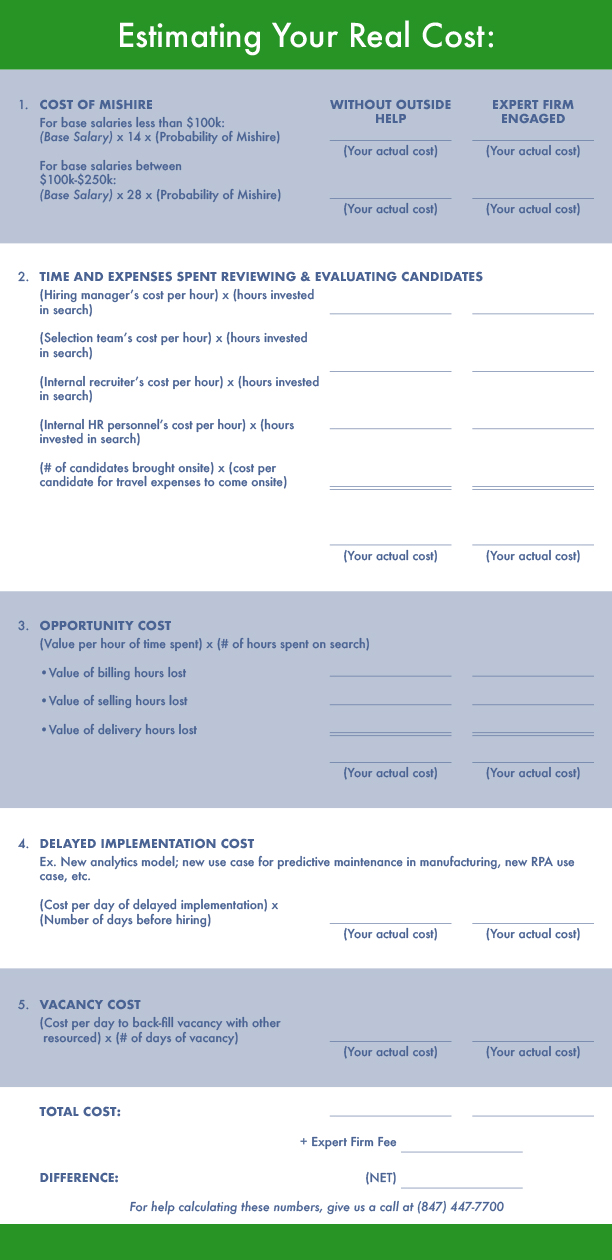Creating High Performing Teams
“I think I’ve got a pretty good team,” you say to yourself. Your key players are smart, qualified, and have proven track records in their fields. Maybe you even feel you’ve got some real all-stars on your team. Yet, research shows that 60% of all teams fail to accomplish their goals,[1] 70% of organizations have suffered at least one project failure in the last 12 months,[2] and 77% of completed projects fail to deliver their intended results.[3]
Why is this happening and how can it be fixed?
First, let’s re-examine the idea that great talent makes a great team. In February 1979 the NHL’s All-Star team competed in the Challenge Cup against the Soviet Union’s national ice hockey team. Although the All-Stars started off with a 4-2 win in the first game, the Soviets came back to win the second game 5-4 and shocked a packed Madison Square Garden by winning the third and final game of the series with a 6-0 shutout.
This outcome stunned the ice hockey world and provides a powerful lesson: individually, each member of the All-Star team was arguably more talented and their stats outmatched those of the Soviet players. However, the All-Star team was made up of players from 11 different teams in the league, borrowed from their respective teams for a weekend in the middle of their regular season. Ultimately, the individually superior but collectively dysfunctional (by comparison) All-Stars were unable to overcome the much more cohesive Soviet team with superior knowledge and practice at working well together as a team.
Second, let’s examine one of the most visible outcomes of team dysfunction: project failure. In a survey conducted by the Project Management Institute (PMI), the five most frequently cited reasons for failed projects are:
- Change in organization’s priorities (39%)
- Change in project objectives (37%)
- Inaccurate requirements gathering (35%)
- Inadequate vision or goal for the project (29%)
- Inadequate / poor communication (29%)[4]
Changes to an organization’s priorities or a particular project’s objectives let teams off the hook, perhaps too easily. Projects can be viewed as naturally evolving and stigma can be applied to cautious team members who resist change. Perhaps not at the conscious level, but at least subconsciously, people who are naturally innovative and seek change believe that their trait is more valuable and can view resistance to change negatively. Couple this with high dominance in a naturally innovative change seeker and team members who resist change can be ignored, marginalized or get kicked off the team altogether. In truth, citing a change in the organization’s priorities or a particular project’s objectives may be masking team dysfunction.
Similarly, people who are naturally supportive may, often subconsciously, avoid conflict. While avoidance of healthy conflict is certainly a sign of dysfunction in its own right, it can produce an additional problem that can be a death sentence for any objective your team tries to carry out: avoidance of accountability. The problem inherent in avoidance of accountability is self-evident: team members who do not hold each other accountable and are not held accountable themselves are at much greater risk for not achieving their goals, because nobody is openly expressing that the goals actually have value that is worth pursuing.
Clearly, inaccurate requirements gathering implies not having necessary information. However, it also implies a failure to understand the requirements of the team and to assemble the right people for the team in the first place. When assembling teams, it is important to keep in mind that people function differently from one another. Understanding the similarities and differences between individuals is just as vital to determining a team’s success as their domain and technical expertise. For example, people who are naturally patient require time and the opportunity to process the need for change and clear, consistent priorities in order to be effective. In the presence of urgent people with high dominance or extroversion, they can be forced to give immediate answers or their input may not be heard at all. Yet, they may possess information or insights that are critical to project success.
At this point you may find yourself saying:
“Well yes, that’s all well and good, but I already know my team struggles with these things. How do I fix it?”
Good! In order to bring about a new, desired state of being, recognizing the need for change is the first step. One has to admit there’s dysfunction. Step two is desiring the change. Namely, one has to embrace a serious commitment and willingness to do what’s required to create a high performing team. The third step is locating the pieces that – if incorporated into the team – can help them rise out of their dysfunction. This third step is where people often get off track.
Leading experts, including Harvard Business School professor Gerald Zaltman, say that 95% of decision making takes place at the unconscious level.[5] Further, they point out that real decision making is not only unconscious, it’s instant and biased. As a result, in order to be effective, teams need to recognize:
- How much decision making is actually unconscious, instant and biased;
- That each individual runs a unique, subconscious “program;”
- That these programs and how they work best together have to be understood by the whole team and, especially by those forming the teams in the first place, and
- That this philosophical knowledge is the precursor to bringing about that desired state of being known as a “high performance team” but that this knowledge must become habituated in order for the team to enter into that desired state.
This last point is particularly important and, it’s the reason we see people read self-help books without ever realizing the state of being that lead them to read those books in the first place. The people that are part of a dysfunctional team (i.e. the subconscious programs they are running that are causing their collective dysfunction) cannot enter into their desired state. They have to actually become the people (begin running the subconscious programs) that are consistent with their desired state of being. In a recent Gartner forum, a highly successful CIO was asked what the biggest surprise was in her digital transformation efforts. Her response: “How long it’s taking for her teams to gel and work well together.”
To see whether or not a lack of habituated knowledge of how your team works best together is at the root of your team dysfunction, take this quick assessment. On a scale of 1 to 5 (5 = yes/always;4 = usually; 3 = sometimes; 2 = rarely; 1 = no/never), evaluate the following five statements:
If you scored a 16 or less, you’ve just taken the first step: recognizing the need for change and opportunity for improvement. Are you ready to take the next step and embrace a serious commitment and willingness to do what’s required to create a high performing team?
About iHs Retained Search
It is rare that peoples’ basic / natural self (the way one behaves without any outside pressure for adjustment, unconsciously) is thoughtfully and intentionally taken into account when assembling teams. It is also uncommon for teams to possess a mutual understanding of the similarities and differences of each other’s basic / natural self and habituated knowledge of how they work best together.
iHs combines a deep understanding of human dynamics with expertise in behavioral assessment tools – such as PDP – with their Partners’ peer level technology and leadership experience and expertise gained from the completion of thousands of technology search and leadership development engagements to help their clients:
- Discover and Acquire Technology Leaders and Key Contributors that Succeed
- Create the Digital Technology Organization for tomorrow
- Improve the Performance of Technology Leaders and Teams
- Succeed at Leadership Transitions
60% of all teams fail to accomplish their goals,[6] 70% of organizations have suffered at least one project failure in the last 12 months,[7] and 77% of completed projects fail to deliver their intended results.[8] By contrast, teams that complete an iHs team development workshop and the prescribed exercises after the workshop to habituate what they’ve learned go on to succeed at their mission better than 95% of the time.
Testimonials from iHs’ clients
“The process that iHs took us through was excellent. We had been using lots of different methods and systems to force an external conformity and in an effort to get the performance we wanted. iHs changed the way we think about assembling teams and initiating teamwork. This helped us create an environment where we discovered many of our frogs where actually princes!” – President, industrial services organization
“This was enlightening. Now I understand why no matter how much clear direction and positive and constructive feedback I was giving several of my leaders they never consistently did what I and their customers were hoping they would. Even though they were outstanding performers in their previous roles, who they are naturally just isn’t the right fit for their current role.” – VP of IT, Fortune 500 company
At iHs, our mission is human flourishing. Our deep desire is to see people go to work inspired and come home feeling satisfied. To learn more or to start a conversation, visit iHs’ website at https://www.ihsrs.com or give iHs a call at (847) 447-7700.
———————————————————————————————————————————————————
Sources
The Real Cost of Your Essential Hires
For decades, the world’s best companies have utilized retained search firms to hire their top executives. This is because they know that making a great hire versus a mediocre hire at this level is critical, and the cost of making a mis-hire can be catastrophic. But what about your company’s essential hires? You know, those Senior Manager and Director-level hires that your company has deemed essential — who will be on the front lines delivering on your company’s strategy, leading your company’s digital transformation or ERP initiative, possibly even in a role that represents a new capability for your organization such as data science, intelligent automation/RPA, or digital manufacturing. Essential hires represent one of the most important business decisions you’ll ever make. Now, more than ever, it’s important to know… How can I reduce the real cost of making my essential hires?
When beginning the hiring process for these positions, many organizations feel as if they should attempt to handle the search internally before engaging an outside firm. This feeling is most often based on one or more of the following assumptions:
- The cost of engaging an outside firm to conduct the search will be greater than the cost to handle the search internally;
- All hires are equal;
- Nobody from an outside firm could possibly understand the role and how to succeed in it better than people within the organization;
- The internal talent acquisition team’s interests are better aligned with the hiring manager’s than the interests of an outside firm.
Wanting to handle hiring internally for an essential hire is often founded in a genuine desire to be a good steward of an organization’s time and resources. But are these assumptions about engaging an outside firm correct?
Your Real Cost
In the real world of recruitment, mis-hires are unfortunately common. A study from Gallup indicated that companies fail to choose the candidate with the right talent for the job a staggering 82% of the time,[1] and The Recruiting Roundtable stated that “Selection decisions are often about as accurate as a coin flip. Fifty percent of the time, they are regretted.”[2] The frequency with which organizations miss the mark when hiring can bring significant costs, ranging from a loss of up to 14 times the base salary of an employee earning less than $100k to up to 28 times the base salary of an employee earning between $100k and $250k according to Recruiting Roundtable [3].
What is a hiring manager’s time worth? The typical Director at a Fortune 1000 company costs their company between $120 and $200 per hour and the typical VP between $200 and $325 per hour. Let’s imagine the hiring manager is a VP and they have an interview panel of two Directors and three VPs. If the hiring manager spends an average of four hours evaluating each candidate they select to interview before they make their final hiring decision and the rest of the panel spends two, then each candidate that makes it through the process costs the organization between $2,500 and $4,000 just to be evaluated by this group. Evaluate four candidates and your organization has spent $10,000 to $16,000, evaluate eight and you have spent $20,000 to $32,000! And this is before considering any other internal costs, such as how much time other members of your organization spends with each candidate, how much time your hiring manager spends reviewing resumes and the costs of bringing candidates onsite to meet with you in person.
Besides these direct costs, what are the opportunity costs of a hiring manager’s time? If you’re a consulting firm, every hour an associate spends interviewing is in an hour that the associate didn’t spend billing or developing new business. If you’re a technology leader in a Fortune 1000 company, every hour spent on your search is an hour not spent delivering on a project that could be driving your company forward.
Furthermore, what’s the cost of a position left unfilled? If you’re a consulting firm that charges $300 an hour, it’s $2,400 a day (or $50,000 a month) in lost billings alone for billable consultants. If you’re a Fortune 1000 company backfilling that role with a contractor or consultant that costs two to three times your future employee, it’s $800 to $1,600 a day ($18,000 to $36,000 a month) plus expenses for positions with a $150,000 annual salary.
Most organizations calculate cost per hire by simply dividing all their recruiting costs by the number of hires made in a specific period. But all searches are not created equal. What’s your internal search really costing you if it…
- Increases your likelihood of making a mis-hire;
- Causes your hiring managers to spend more time on it;
- Prevents your hiring managers from spending more time billing, selling, or delivering products or services to your company and its customers;
- Delays your implementation of valuable products or services;
- Prolongs your use of more expensive resources?Calculate Your Real Cost
Click the image for your customized worksheet.

All Hires are Not Equal
Just as all searches are not equal, neither are all hires. When it comes to essential hires, now more than ever “good enough” isn’t good enough. When an organization is searching for candidates who will be operating in one of those Senior Manager or Director-level roles – again, one of those individuals who will be on the front lines delivering on your company’s strategy, leading your company’s digital transformation or ERP initiative, possibly even in a role that represents a new capability for your organization such as data science, intelligent automation/RPA, or digital manufacturing – their goal should be to discover and acquire an A-level performer. Why? According to Accel KKR, “A-level performers…”[6]
- Are 3 to 5 times more productive with a significantly greater impact on both the top and the bottom line of an organization.
- Increase team engagement and actively participate in the organization’s culture. It has been suggested that managers account for at least 70% of the variance in employee engagement.[7]
- Positively impact management through:
- Less time spent at work because A-level performers quickly show they don’t need to be micromanaged.
- Less time spent reviewing their work; A-level performers get it right the first time.
- More innovation; A-level performers bring a fresh perspective that helps drive organizational initiatives forward.
- Building positive relationships with both employees and customers.
What Causes Success is a Mystery to Most
The idea that organizations inherently understand roles better than an outside firm can is a myth. This may sound harsh, but consider the following facts:
- 66% of hiring managers come to regret their interview-based hiring decisions, according to DDI;
- 40% of newly promoted managers and executives fail within 18 months of starting a new job, according to Manchester, Inc.;
- As noted earlier, a study from Gallup indicated that companies fail to choose the candidate with the right talent for the job 82% of the time;
- A survey from Glassdoor found that 69% of hiring companies made a bad hiring decision based on a flawed interview process, with 22% reporting insufficient talent intelligence prior to recruiting.[7]
Another, relevant myth: human beings are rational and logical decision makers. Real decision-making is rapid, biased, and subconscious. Numerous cognitive neuroscientists have conducted studies that revealed that only 5% of our cognitive activities (decisions, emotions, actions, and behaviors) are conscious, whereas the remaining 95% is being generated in a non-conscious manner. The truth is that humans rationalize their decisions after the fact. So, what’s really going on when someone says, “I knew they were the right person for the job in the first two minutes”? They made an immediate, biased decision at the subconscious level and spent two minutes rationalizing it!
Consider this recent quote from Google:
“We looked at tens of thousands of interview results… and how that person ultimately performed in their job. We found zero relationship. It’s a complete random mess.”
Alignment of Interests
Internal Recruiters
According to SHRM internal recruiters work an average of 30-40 searches simultaneously, and the median is 15-20.[4] Furthermore, some estimates indicate that internal recruiters spend as much as 60% of their time in administrative tasks such as non-recruiting phone calls and emails, scheduling interviews, training and education, and internal meetings and initiatives. In other words, the average internal recruiter working a 40-hour week has less than 30 minutes each week to work on each search. Sure, one can increase these metrics by 50% for that corporate recruiter willing to put in 12-hour days and 60-hour work weeks. However, that will still only result in one and a half to three hours a week per search, and workload is cited as one of the reasons that 90% of all corporate recruiters turn over in the first 12 months.[5]
A key metric for all recruiters is time-to-fill. As a result, internal recruiters must carefully choose where they spend their limited time or risk causing the searches that are easier to fill to take longer as they get bogged down on the more unique, highly competitive and hard to fill searches (such as your new data science, ERP, or digital manufacturing search). Also, when a role is brand-new to a recruiter, how do they determine if the position they are about to work on is going to be one of the easier ones or one of the more difficult ones? Lastly, because corporate recruiters often have heavy search loads, they rely heavily on their hiring managers to define their roles and vet their candidates.
Contingency Firms, RPOs, and Retained Search Firms
Contingency firms are only paid if you pick their candidate. As a result, their incentive is to see their candidate get placed, whether that be at your company or someone else’s. The typical recruiter at a contingency firm works 20-30 searches simultaneously, and in short bursts.
RPOs are paid by the hour. As such, they are incented to bill hours and keep costs down in order to optimize margins. The recruiters at RPOs, like their corporate recruiter counterparts, work an average of 30-40 searches simultaneously with a median of 15–20.
Retained search firms are paid a fixed amount, typically at the beginning, middle, and end of the engagement based upon a position’s compensation, to develop and manage the entire search process. As such, their incentive is to see your project completed successfully. The Partner at your typical retained search firm works an average of 3–5 searches simultaneously.
Conclusion
If one wants to responsibly manage their company’s resources, what should they do? Don’t wait. Pick the right partner for your essential hire, right from the start. Waiting won’t just chew up the valuable time of your internal recruiters, executives, and their peers; it will cost your organization more money and produce less predictable results. Selecting who gets hired for one of those Senior Manager or Director-level roles will be one of the most important business decisions that executive will ever make.
About iHs Retained Search
It is rare that a person’s “basic/natural self” (the way we behave without any outside pressure for adjustment) is thoughtfully and intentionally aligned with an organization’s new roles and ways of working. It is also uncommon for leaders and teams to possess a mutual understanding of the similarities and differences of the basic/natural selves of team members and how they work best together to create a high-performing team.
iHs combines a deep understanding of human dynamics with expertise in behavioral assessment tools – such as PDP – with their Partners’ peer level technology and leadership experience and expertise gained from the completion of thousands of technology search and leadership development engagements to help their clients:
- Discover and Acquire Technology Leaders and Key Contributors that Succeed
- Create the Digital Technology Organization for tomorrow
- Improve the Performance of Technology Leaders and Teams
- Succeed at Leadership Transitions
Through over one thousand engagements over the last 10 years, iHs has delivered the following results:
- Over 90% of the time clients rate the candidates placed through an iHs search or leadership transition engagement a 9 or 10 out of 10 when ask to rate the candidate’s performance;
- 92% of the time iHs changes or significantly enhances the job description that their client started with, and 100% of the time this job description is translated into a competency model;
- Over 90% of the candidates selected through an iHs search are passive and only evaluating their client’s opportunity;
- iHs’ clients, on average, only evaluate 3 to 4 candidates before making an offer that is accepted and iHs has a 98% offer acceptance rate.
As a result, iHs’ clients often partner with them exclusively to make their Senior Manager and Director-level hires.
Testimonials from iHs’ clients:
“Wow, after 90 days on the job, I barely feel as if I need to manage the person you helped us place in this new role. They just naturally do what I hope that they will be doing every day with very little input from me. Their customers are delighted!” – Senior Manager at a Fortune 1000 company
“This was enlightening. Now I understand why no matter how much clear direction and positive and constructive feedback I was giving several of my leaders they never consistently did what I and their customers were hoping they would. Even though they were outstanding performers in their previous roles, who they are naturally just isn’t the right fit for their current role.” – VP of IT at a Fortune 500 company
“You have great knowledge of what is working out there and what is not and use that knowledge to help me better understand what we should be looking for.” – Director of IT at a Fortune 500 company
“iHs does searches the way I would, if I had the time to.” – Talent Acquisition Senior Manager at a Fortune 1000 company
At iHs, the mission is human flourishing. Our goal isn’t just to ensure the speed, efficiency, and quality of our work, but to see people go to work inspired and come home satisfied. To learn more or to start a conversation, visit iHs’ website at https://www.ihsrs.com or give iHs a call at (847) 447-7700.
To learn more or to start a conversation, give us a call at (847) 447-7700.
____________________________________________________________
Sources:
[4] Gallup: Why Great Managers Are So Rare
[5] ERE: 50% of New Hires Fail
[6] Forbes: 5 Tips for Recruiting the Best Employees
Ready For The New Workforce? Hiring For Newly Created Jobs
At A Glance:
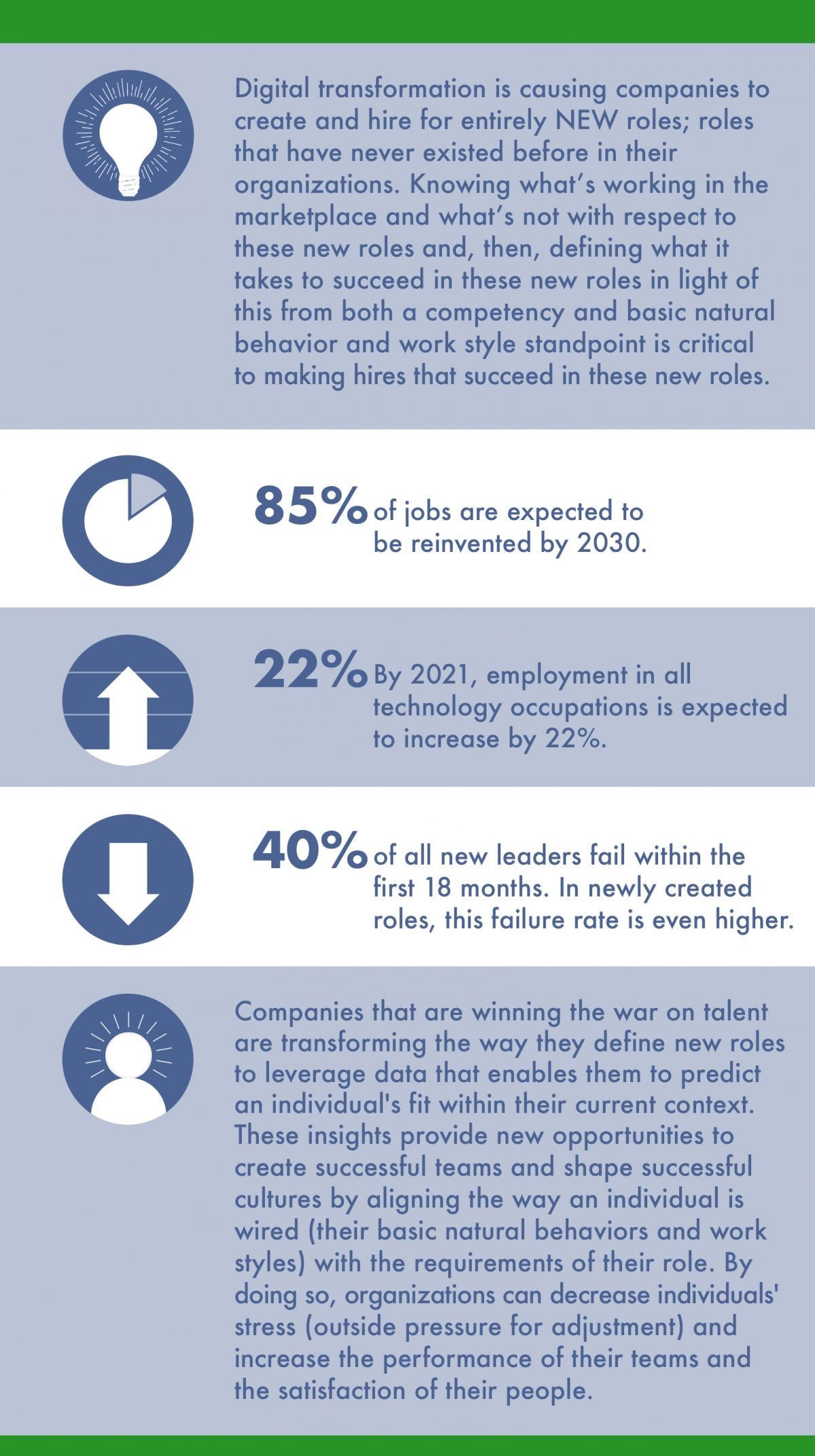
Hiring today is very different than it was just five years ago. Digital transformation is changing the way we work and live, and the U.S. has more job openings than unemployed people—a situation some economists call “full employment” since most job seekers land a job fast.
Today’s high-tech environment has created many career opportunities and job positions that didn’t exist before. The U.S. unemployment rate has been hovering around four percent, which has created a unique hiring challenge.1 As well, according to the World Economic Forum Report, sixty percent of industry leaders believe mobile, cloud technology, big data and computing power are driving change in today’s workplace. 2
Many companies are recruiting for new positions that they’ve never recruited for before such as Social Media Managers, Chief Data Scientists, and Cloud Computing Specialists just to name a few. When you combine the challenges of low unemployment with recruiting for newly created positions, it’s clear that recruiters and employers are facing a novel wave of hiring obstacles.
Successful Disciplines for Future Hiring
Timothy Boyce, Partner at iHs Retained Search, notes, “A recent Gartner Study indicated that 85% of jobs are expected to be reinvented by 2030. This means that companies are going to need to hire for a lot of positions over the next ten years that they have never hired for before.” 3 Preparing for what the future holds will require creative thinking and careful planning by hiring managers and HR professionals. Employers need to appreciate that a profound change is happening right now in the types of work and underlying skills that are needed in the “Second Machine Age.” Any organization that wishes to remain relevant and competitive in the Second Machine Age must equip themselves with this new talent and their associated capabilities. And, they need hiring practices that enable them to effectively distinguish the new leaders that are most likely to succeed from those who are not and then successfully attract them to their organization.
iHs Retained Search recommends applying these seven disciplines when hiring for newly created positions:
Discipline 1: Augment Your Job Descriptions with Competency Models
With any search, an organization first needs to determine the criteria by which they’ll evaluate candidates. To be sure, job descriptions that clearly articulate the duties and responsibilities of a role are required. However, crafting a job description is not enough. iHs advocates translating job descriptions into competency models. Competency models take the job description a step further by defining the competencies that are required to successfully discharge the duties and responsibilities of a job; both from a domain expertise and a leadership and management standpoint.
Discipline 2: Use Your Competency Model to Create Interview Guides and Make Sure Your Interviewers Use Them
Scripts can often feel unnatural when spoken aloud. In the hiring process, the objective behind a script or “Interview Guide” is not to make the interviewer(s) feel uncomfortable or robotic, but rather to equip interviews to be able to accurately identify predictors of success and failure that are specific to a particular role. The view that people are rational and logical decision makers is a myth. Real decision-making is rapid, biased, and subconscious. In reality, we rationalize our decisions after the fact. The best interview guides force interviewers to ask questions that are specifically related to the competency model for your role and are designed to help challenge decision maker’s rapid, biased, and subconscious decision making.
Discipline 3: Hire for Fit of People’s Basic/Natural Self with Your Role
The Basic/Natural Self is the way one behaves without any outside pressure for adjustment. And, by the time we reach adulthood, it rarely changes significantly. According to Boyce, “95% of our decision making takes place in the subconscious mind. The Basic/Natural Self is a representation of these subconscious behaviors and it’s very difficult to change. So, you had better hire for it because, once you’ve made your hire, you aren’t going to change it.” As such, iHs advocates using a behavioral assessment instrument such as PDP to build what’s known as a Job Model for the basic natural behaviors and work styles that are optimal for your role. Then, using your behavioral assessment instrument to determine how well candidates’ Basic/Natural Self match or “fit” your Job Model.
Discipline 4: Hire for Passion
Passion fosters progress. If a candidate truly enjoys what they do, they will naturally work harder at it and continue to refine and improve overtime. This is critical with newly created jobs that lack well developed methods and approaches for achieving success. “You can’t teach people passion and it’s very difficult to change the Basic/Natural Self,” explained Boyce. “As such, in addition to hiring for fit with your Job Model, you had better hire someone who is passionate about what you’re going to have them doing.”
Discipline 5: Monitor and Control the Progress of Your Search Regularly
Protracted searches with large, ultimately fruitless time investments in less-than-ideal candidates are, unfortunately, not uncommon in the hiring world. Searches are projects and they need to be managed like them. Who’s making sure you’re hitting the milestones that will ultimately lead to a timely, outstanding hire? Who’s making sure the scope of your search is appropriately changing when you encounter new information or setbacks? Who’s managing actions to closure and ensuring that stakeholders are effectively utilizing your Interview Guides and sticking to your Job Model? What’s the cost to your organization of a delayed hire? What’s the value of the time of the executives involved in your search? The monitoring and controlling process oversees all the tasks and metrics necessary to ensure that your approved and authorized project (your search) is within scope, on time, and on budget so that it proceeds with minimal risk and delivers your intended outcome… a timely, outstanding hire.
Discipline 6: Improve Your Onboarding Process
A recent study found that seventy-six percent of HR leaders agree that onboarding practices are underutilized at their organization. Digging deeper, sixty percent believe the primary goal of an onboarding program should be to integrate employees into the organization’s culture.4 However, culture makes up less than thirty percent of most onboarding activities. Most onboarding programs are simply too short. Some onboarding lasts a few hours to one week, while just ten percent of organizations treat it as a year-long activity.
iHs advocates using a behavioral assessment instrument to introduce your new hire to their new leader and your new hire to their new team then providing these stakeholders with exercises to complete to habituate what is learned. According to Boyce, “Every new hire goes through a process of storming, forming, norming, and then performing. Often times, the norms settled on are not the ones that lead to the highest performance. This is because stakeholders rarely possess mutual understanding of the similarities and differences of their basic natural behaviors and work styles and how these basic natural behaviors and work styles work best together.”
Discipline 7: Work With Experts Who Understand Your New Position
A survey from Glassdoor found that sixty-nine percent of hiring companies made a bad hiring decision based on a flawed interview process, with twenty-two percent reporting insufficient talent intelligence prior to recruiting.5 What’s working out there and what’s not in that new role? What competencies are the driver variables when it comes to predicting success at that new role? What’s it take to attract the best and brightest at that new role and how do you avoid competing with everyone else for them? According to Boyce, “If your job description, competency model, and Job Model don’t take into account intelligence on what’s working out there in these new roles and what’s not and your interview process doesn’t include intelligence on what it takes to succeed at a search for one of these new roles in a timely manner, you’re setting yourself up for failure. Hiring their leaders is one of the most important business decisions an executive will ever make.”
About iHs Retained Search
iHs Retained Search combines expertise from the successful completion of thousands of searches for key contributors at Fortune 1000 and high-growth companies with search leadership by Partners with first-hand, peer-level experience in the searches they lead. iHs’ Partners are all ex-CIOs, VPs or Directors of IT, CMOs, CEOs, and/or Management Consulting Directors or Partners. Using rigorous processes, state-of-the-art research technologies, competency model development and behavioral assessment tools, iHs saves their clients time and helps them make and on-board hires that “fit”—hires that manifest excellence. iHs’ clients evaluate three to four candidates on average before making an offer and iHs has a better than 98% offer acceptance rate over the past 10 years. More than 90% of the candidates presented by iHs to their clients are not active job seekers and are only evaluating their client’s job opportunity. And, 98% of the candidates placed by iHs receive a score of 9 or 10 out of 10 when clients are ask if they would make the same hire again.
To learn more or to start
To learn more or to start a conversation, give us a call at (847) 447-7700
Succeeding at Leadership Transitions
Succeeding at Leadership Transitions
After two years, nearly half of all senior leadership transitions are regarded as failures or disappointments. Executive transitions, whether at the Director, Vice-President, or C-level, create uncertainty and are typically high-stakes, high-tension events. When asked to rank life’s challenges in order of difficulty, the top one is “making a transition at work” – ahead of bereavement, divorce, and health issues according to a study by DDI.1 As many as 74 percent of US leaders and 83 percent of global ones think they are unprepared for their new roles. Organizations most often try to help newly appointed leaders by supplying them with mentors or informal buddy networks. Yet, only 47 percent of external hires and 29 percent of internal ones find these helpful. Standard orientation programs are the second most common approach. However, only 19 percent of externally and 11 percent of internally recruited executives consider them effective. Customized assimilation plans and tailored executive coaching have been shown to double the likelihood of success, yet only 32 percent of organizations use them. What’s more, 98% of leaders believe a succession plan is important, however, according to a recent survey by a global organizational consulting firm, only 35% have a plan in place.2
What is Succession Planning?
Succession planning is the process of identifying and developing the people and plans to successfully transition a role from one leader to the next. It typically involves identifying key roles for succession planning, defining what it takes to successfully execute in the role, assessing people against these criteria, identifying who could potentially perform highly in the role, and then developing those identified to be ready to execute in the role. It’s not just about the people that are already at your company. According to a recent Stanford University study, 61% of companies believe that they have no viable internal candidate for their most senior leader and leadership transitions impact organization’s entire ecosystems.3
Succession planning is not just for the CEO either. It’s important for all your leadership roles. Selecting your leaders is one of the most important business decisions you’ll ever make. And, leadership transitions are not a question of if, but when. Everyone eventually leaves their role; everyone.
To Prepare is Half the Battle
Leadership transitions are high-stakes, high-tension events. In our work with hundreds of companies the following seven practices rise to the top when it comes to successful leadership transitions:
- Define how your leadership roles fit into your overall business strategy. This step ensures that the investment in future leaders reflects the organization’s strategic direction. As Marshall Goldsmith said, “What got you here, won’t get you there.” 4 Companies can tend to think of their leadership roles as static. Nowhere is this more problematic than in technology related leadership roles where more than 50% of hires in the coming years are expected to be for roles that never existed before. It’s important to understand how a company’s strategy will impact the roles of its leaders. Align your vision for your leadership roles with your business strategy and vision. Then, thoughtfully define the competencies, values, and basic natural behaviors and work styles that fit this vision and are required to take your leadership roles to the next step in their evolutionary and, sometimes revolutionary journey.
- Include all key stakeholders. Succession planning and the development of associated transition plans should be a continuous process that involves the key stakeholders within your organization as well as key external stakeholders that can provide leaders with important external perspectives. If your organization has key partners in the field of talent and organizational development or strategy formulation and execution, include them. If your company has customer, alliance, vendor and/or other partner advisory boards, include them for leadership roles that interface with them. Make sure these external relationships are relevant to the leadership role you’re including them in on and see them as your ally in the process. Involve trusted advisors from inside and outside the company.
- Identify and evaluate the fit of potential successors – 40% of all new leaders fail within the first 18 months, mostly due to poor fit. Poor fit is 100% preventable. High performance in one role does not equate to high performance in another. Consider the classic example of the high-performing salesperson who flops as a sales manager. Why does this happen? One reason is the fit of the basic natural self (the way one behaves without any outside pressure for adjustment) with the basic natural behaviors and work styles required to manifest excellence in the new role. The basic natural self is very difficult to change. By the time people reach the age of assuming leadership roles in organizations, they have been practicing being who they are for many years and most of what drives their behaviors is unconscious to them. High performance comes easiest when people are just being who they are naturally, without any outside pressure for adjustment, and find that, who they are naturally is just what the role demands. Remember too, what got you here won’t get you there. The basic natural self of the leader that got you to where you are is not always the basic natural self of the leader needed in the next iteration of the role. As such, develop a model of the basic natural self required for success in the next iteration of the role (not the current iteration) and evaluate the fit of potential successors’ basic natural self against it.
- Create a stewardship mentality. Planning for and executing the smooth transition of senior leadership positions is key to the sustainability of any organization. Even if you don’t think you’ll need to replace a leader in the near future, establishing a culture of mentoring leaders with transition planning skills is foundational to good stewardship. Good leaders understand it is critical to pass on what has been entrusted to them. Yet, many companies lack a formal succession planning process which is only exacerbated by their current leaders living longer or not entrusting more responsibility and authority to their team. Succession planning and the development and maintenance of associated leadership transition plans should not be delegated to HR. Every leader eventually leaves their post. Help leaders see themselves as stewards of their role and have them own their succession plan, including the development and maintenance of its associated transition plan. Include it in their job description and performance evaluation and even consider linking it to their compensation. Then, utilize HR professionals who have first-hand experience helping leaders successfully navigate transitions and who have successfully navigated leadership transitions themselves to aide your leaders in the development and maintenance of their transition plans for the role they are stewarding.
- Engage successors in real-world experiences. Acquiring philosophical knowledge about the duties and responsibilities of a new role and the competencies required to successfully execute those duties and responsibilities is a precursor to being able to execute them well. However, experiences are required to habituate that knowledge. The best transition plans include real-world experiences, where successors are given the responsibility and authority to execute in the real-world situations they will face in their future role. It’s estimated that 95% of brain activity is beyond our conscious awareness. Numerous cognitive neuroscientists have conducted studies that show that only 5% of our cognitive activities (decisions, emotions, actions, and behaviors) are conscious. Through real-world experiences, successors literally wire the neural pathways that form the unconscious habits required to succeed in their future role in advance of taking on the role.
- Plan the power hand-off. The power hand-off is the part of the transition plan that specifies how and when the responsibility and authority for executing the duties and responsibilities of the role will be transitioned. If an overlap is planned, it’s important to make sure who has responsibility and authority until when is clear and not given and then taken away nor, once given, undermined. Many veterans of leadership transitions believe that it’s best for an exiting leader to make a clean break from the organization and not linger. A clear and orderly hand-off of responsibility and authority is key in order to not undermine the new leader and their ability to execute.
- Develop an internal and external communication plan. Communication impacts peoples’ reactions and, because of this, it can determine the outcome of change. The most effective practice in organizational change management is effective communication plans. In second place is effective execution of the communication plan. A great communication plan answers the following three questions… Why is this change happening? What is the risk of not changing? What’s in it for me? The best transition plans include communication plans that answer these three key questions and also provide a two-way street for communication with multiple channels to receive feedback through and structured ways to respond to that feedback.
To be prepared is half the battle when it comes to succeeding at the high-stakes, high-tension event known as a leadership transition. iHs combines intimate knowledge of industry and technology trends with expertise in behavioral assessment and human development as well as technology leadership executive search with their Partners’ peer level experiences in roles such as: CEO, CIO, Managing Director, Partner-in-Charge, President, and Sr. Vice President at high-growth businesses, leading professional services firms and industry titans to help technology leaders prepare for the high-stakes, high-tension event known as a leadership transition. Consider the following quote:
“The process that iHs took us through is what I would consider to be the Gold Standard.” – Board Director and CEO of a Fortune 500 CPG company
To learn more or to start a conversation, give us a call at (847) 447-7700.
The Human Side of Your Digital Transformation
Welcome to the age of digital disruption. The Gartner 2019 CEO and Senior Business Executive Survey, qualified and surveyed 473 business leaders of companies with $50 million or more in annual revenue. 60% of these 473 business leaders were at companies with $1 billion or more in annual revenue. According to this survey, 82% of respondents agreed that they had a management initiative or transformation program underway to make their companies more digital – up from 62% percent in 20181. At the same time, this survey showed that CEOs are concerned that some of the executive roles do not possess strong or even sufficient digital skills to face the future. On average, CEOs think that sales, risk, supply chain and HR officers are most in need of more digital savvy. When ask which organizational competencies their company needs to develop the most, talent management topped the list, closely followers by technology enablement and digitalization and data centricity or data management.
Digital technology can significantly improve the performance of businesses and even give birth to entirely new operating models that shake up sectors (the newspaper and recording industries are cases in point). Yet, only a paltry 14 percent of 1,733 business executives polled by McKinsey in September 2018 said that their digital transformation efforts have sustained performance improvements, with only 3 percent reporting complete success at sustaining change. To address this, McKinsey lays out a roadmap for a digital transformation that involves 10 steps.
- Secure senior management commitment
- Set clear, ambitions targets
- Secure investment
- Start with lighthouse projects
- Appoint a high-caliber launch team
- Organize to promote new, agile ways of working
- Nurture a digital culture
- Sequence initiatvies for quick returns
- Build capabilities
- Adopt a new operating model
But, appointing a high-caliber launch team, organizing to promote new, agile ways of working, and nurturing a digital culture is about more than acquiring technical skills (“digital savvy”) and coming up with new operating models.
First, it’s about fit. Matching people’s basic natural self with the roles they will play in that launch team or in the organization’s new operating models and ways of working. Then, second, it’s about diversity. Diversity of basic natural behaviors and work-styles coupled with mutual understanding and appreciation for each other’s similarities and differences and how these basic natural behaviors and work-styles work best together. Then, finally, it’s about the mindful habituation of this mutual understanding and appreciation and new ways of working together. All three are required in order to successfully transition to and sustain that change that, in essence, represents a new state of being for an organization.
The Basic Natural Self
Everyone has a basic natural self. The basic natural self is the way one behaves without any outside pressure for adjustment. And, the basic natural self seldom changes once a person reaches adulthood. This is because, by the time one reaches adulthood, they’ve practiced being a particular basic natural self for a long time. And, the longer we’ve practiced being a particular basic natural self, the harder it can be to change it.
Matching Basic Natural Selves with New Roles
The fact that the basic natural self seldom changes is the reason it’s extremely important to match people with roles and ways of working that are a good fit with their basic natural self. Think about hiring a battle field sergeant for your army. To be effective, they need to be swift decisions makers, take charge, tell people what to do, and not care too much about being liked. Now, take that same set of basic natural behaviors and work styles and ask that person to sit by the bedside in a hospital and patiently, supportively, and empathetically council people all day. What do you think will be going through their mind 30 seconds into their first counseling session? What do you think they’ll do?
The same is true with your new roles and ways of working. For example, take the machine operator who has been manually operating that expensive piece of equipment running on your shop floor for years. He or she is flexible and adjustable and that makes them great at optimizing overall equipment effectiveness as the ways in which that machine is utilized constantly change. But, now your new digital manufacturing solution is doing that by constantly analyzing inputs from a variety of sensors and using data, algorithms, statistics, and machine learning to optimize overall equipment effectiveness. This presents a new way of working for the machine operator. Now, your machine operator is overseeing a new, connected digital system that requires a structured, consistent way of interacting with it… the exact opposite of the basic natural behaviors and work styles that were required before.
Diversity
Building a great team, whether it’s your launch team or a new operating team, is like building a life raft. In order to survive, you not only need a diverse set of skills and abilities, you also need a diverse set of natural behaviors and work styles. And, just having this diversity is far from enough. It takes mutual understanding of and appreciation for the similarities and differences each team member brings to the life raft (i.e. to your launch or new operating team) AND how this unique combination of natural behaviors and work styles performs best together in order to thrive.
Consider the case of launching and instantiating an advanced analytics capability. The goal is to harness data and analytic models to optimize business outcomes. This is done by sourcing data creatively, identifying analytics models that allow managers to predict and optimize outcomes, and transforming a company’s culture to exploit analytics successfully. What’s it mean to transform a company’s culture to exploit analytics successfully? It means lots of new ways of working such as:
- Being specific about the business problems and opportunities the organization needs to address and getting creative about the potential of external and new sources of data.
- Encouraging the development of models that are the least complex to improve performance.
- Working with senior executives and their managers to build understanding of and trust in analytic models and data.
- Working with frontline managers to ensure analytics and tools complement existing decision processes and encouraging the development and execution of new decision processes that take advantage of analytic models.
- Identifying and implementing training, role modeling by leaders, and incentives and metrics to reinforce behaviors that utilize data and analytic models that allow managers to predict and optimize outcomes.
Each of these new ways of working will invariably bring together a corresponding diversity of basic natural behaviors and work styles. For example, an organization’s high-energy, assertive, creative, and intuitive sales manager will now be working with a “digital worker” in the form of an analytical model that produces predictions and prescriptions that may run counter to their intuition from time-to-time. This sales manager in turn may be supported by a data scientist with lower energy who is supportive and systematic and fact based in their decision making. In this new relationship, the sales manager can help the data scientist be more creative about external and new sources of data and produce quicker decisions based on simpler models and the data scientist can help the sales manager make better, more fact-based decisions that result in better business outcomes. But, mutual understanding and appreciation of each other’s similarities and differences and how they work best together will be required to get the most out of their relationship. For example, the sales manager will need to appreciate and understand the value of giving the data scientist time and the opportunity to process their requests for change rather than demanding immediate responses and the data scientist will need to learn to discuss how changes will be handled and establish in advance that changes are to be agreed upon together before implementing.
Habituating new ways of working
Have you ever noticed that people read all kinds of self-help books but rarely change? This is because philosophical knowledge is a pre-cursor to bringing about and sustaining a new state of being but, philosophical knowledge by itself will not bring about that new state of being. The same is true of an organization’s digital transformation because, in essence, it’s a transformation to a new state of being. Most people effectively go unconscious shortly after waking up each day; quickly slipping back into the unconscious emotions, habits, and/or hardwired attitudes of the past. These form the basic natural self that we described earlier and create a predictable future in the image of the past. The challenge is to properly fire and wire new thoughts and emotions (of one’s future) into one’s brain and heart every day. In order to do this, it takes imagination and practice. Imagination because one must have a clear, firm image of their desired new state of being and practice because practice is what’s required to supplant old habits with new ones.
In business cases for Robotic Process Automations, the assertion is often made that current workers will be freed up to work on higher value activities that only a human can perform. But, take the case of an auditor in a risk department, who’s basic natural self is to be cautious and require proof and work deliberately with accuracy and follow-through. This makes them highly effective at working through mountains of data to spot errors and ensure compliance. Now that a company’s new “digital worker” or “bot” (short for “robot”) is going to perform this function, does the work that auditor is now freed up to do require the same basic natural behaviors and work styles? If not, the auditor and their company are faced with two choices. Either that auditor must create a new image of themselves and practice being that new person until they have wired and are firing new thoughts and emotions consistent with who that new person is every day or their company needs to move them into a role that still requires someone who is cautious and requires proof and works deliberately with accuracy and follow-through. This is because, until that person creates these new habits, no matter how much education and positive and constructive feedback they are given, the way they work (their basic natural behaviors and work styles) won’t change. They’ll experience constant pressure for adjustment (known as stress) and the company will experience sub-optimal performance.
Digital technology can significantly improve the performance of businesses and even give birth to entirely new operating models that shake up sectors. But, appointing a high-caliber launch team, organizing to promote new, agile ways of working, and nurturing a digital culture is about more than acquiring technical skills (“digital savvy”) and coming up with new operating models. It requires matching people’s basic natural self with their new roles and ways of working together, developing mutual understanding and appreciation for each other’s similarities and differences and how these basic natural behaviors and work-styles work best together along with habituating new ways of working in order to enter into and sustain the new state of being that an organization’s digital transformation represents.
About iHs Retained Search
There are many who can do the job but, few who will manifest excellence in it. Poor fit is costly but, it’s also 100% preventable. iHs Retained Search combines expertise from the successful completion of hundreds of searches and leadership advisory engagements for digital technologists and leaders in areas such as Advanced Analytics, Block Chain, Digital Manufacturing / Industry 4.0, Intelligent Automation, and Security with engagement leadership by Partners with first-hand, peer level experience in the engagements they lead, rigorous process, state-of-the art research technologies, competency model development and behavioral assessment tools to help their clients discover, acquire, and develop digital technologists and leaders that fit. iHs’ clients evaluate three candidates on average before making an offer and iHs has a better than 98% offer acceptance rate over the past 10 years. Consider the following quotes from iHs clients:
“This was enlightening. Now I understand why no matter how much clear direction and positive and constructive feedback I was giving several of my leaders they never consistently did what was I hoping and their customers were expecting.”
– Global VP of IT at a Fortune 500 company
“Wow, after 90 days on the job, I barely feel as if I need to manage the person you helped us place in this new role. They just naturally do what I hope that they will be doing every day with very little input from me. Their customers are delighted!”
– Senior Manager at a Fortune 1000 company
To learn more or to start a conversation, give us a call at (847) 447-7700.
How are you winning the war for talent?

It’s not a secret that there are an abundance of new recruiting tools and services available to help you find talent for your organization. However, according to the KPMG U.S. CEO Outlook 2019 report, the adoption of these new recruiting technologies and services has only heightened the war for talent. Further, according to a recent study by MRInetwork, a majority of job openings are for newly created positions. This shift, combined with the aforementioned use of new technologies and services and a shrinking pool of active job seekers, has companies that are serious about winning the war for talent rethinking their talent acquisition strategies.
For years the world’s best companies have utilized retained search firms to hire their top executives. This is because they know the impact of making a great hire versus a mediocre hire at this level is significant and the cost of making a mis-hire can be catastrophic. But what about your company’s key contributors? Those Manager, Senior Manager, Director and Vice President level hires who will be on the front lines delivering on your company’s strategy, leading your company’s digital transformation, and/or in one of those newly created positions?
One of the most important business decisions you’ll ever make is the leaders you hire.
In an effort to fill key contributor positions more quickly and make better hires, some companies have increased the size of their internal recruiting organization or outsourced it to a third party. Other companies have increased their usage of contingent search firms – those search firms that are only paid if you hire one of their candidates. But what does it really take to fill these key contributor positions more quickly and, at the same time, make better hires; especially when it’s for a new position that your company has never recruited for before? What does it take to win in the war for talent for your key contributors?
First, have you considered that your total cost to acquire your key contributors using contingent search firms, beefing up your internal talent acquisition team or outsourcing it might actually be higher than you think? Take using contingent search firms for example. Sure, they may charge you a smaller percentage of a candidate’s first year salary than a retained search firm. But, your method of compensating them actually incents them to increase your internal costs and your competition for talent. Since a contingent search firm is paid only when someone they present gets hired, they are incented to send you as many people as they can as quickly as they can and, to send those same candidates to as many places as they can to get them placed. This increases your internal activity costs related to filtering through the candidates to discover fit and increases your competition for those candidates.
On the other hand, outsourcers and contract recruiters are incented to bill hours and to deliver their service to you at their lowest pratical internal cost in order to improve margins. This means hiring people who are earlier in their careers or in lower cost parts of the world in order to keep costs down. Take a look at the following chart and count the costs.
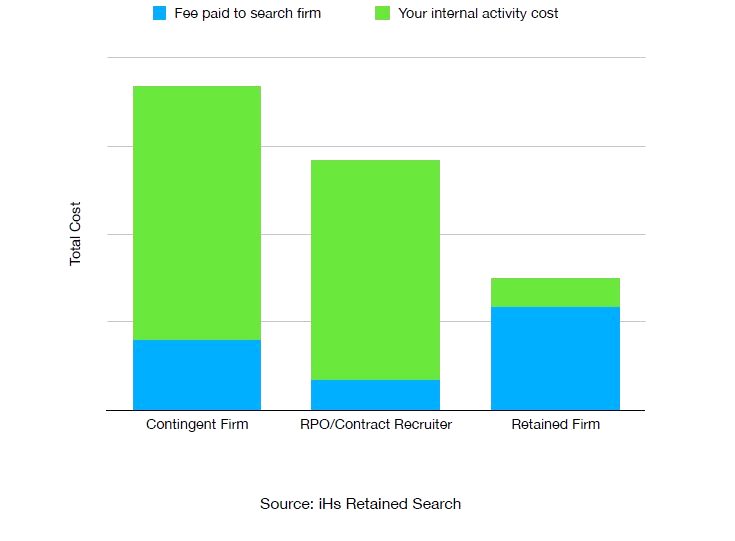
Some key elements of total cost:
Fees paid
Typically, 20-25% of a candidate’s first year salary for a contingent search firm vs. 30-40% for a retained search firm and “by the hour” for a Recruitment Process Outsourcer (RPO) or contract recruiter.
Number of candidates
This is the number of candidates that you need to evaluate (whether via simply reviewing their resume, interviewing them over the phone, or bringing them on-site for interviews) to find the one person you want to hire that accepts your offer and joins your company.
Number of offers
This is the number of offers you have to make before a candidate you select accepts your offer and joins your company.
Poor fit
40% of all new leaders fail within the first 18 months; mostly due to poor fit. Poor fit is 100% preventable. Further, high fit leads to measurable contributions to productivity and corporate culture. According to Accel KKR, “A” players:
- Are 3-5x more productive with significantly greater impact on top and bottom lines.
- Increase team engagement and participate more actively in corporate culture.
- Positively impact management via:
- Less time spent at work → lower probability to micro manage.
- Less time spent reviewing work due to fewer errors → “Get it right the first time.”
- More innovation.
- Better relationships with other employees and customers.
Regretted hiring decisions
According to Recruiting Roundtable, organizations or new hires regret hiring decisions 50% of the time. According to Accel KKR, the tangible costs associated with mis-hires are staggering:
- 14x salary for employees with a base salary < $100k.
- 28x salary for employees with a base salary between $100k and $250k.
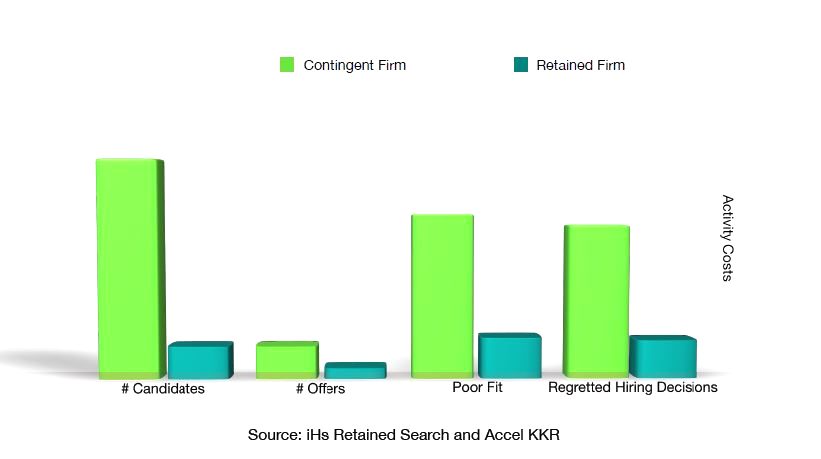
Not only is your total cost lower when working with a retained search firm for your key contributor hires, but you can also expect to receive the following value-adds that will impact your total cost metrics and improve your company’s business outcomes.
1. Exclusive Access: Retained search firm’s leverage their independence, reputations, and knowledge of markets to enable you to recruit not only active candidates but, importantly, passive candidates. Independence and a reputation for focusing on discovering a great fit vs. getting a placement greatly increases retained search firms’ ability to reach passive candidates; those candidates that are highly valued employees at other companies such as your competitors and not actively looking for a new job. Further, within the retained search community, boutique or niche retained search firms have smaller hands-off client lists and therefore broader reach than larger, brand name retained search firms. Retained search firms, unlike contingent firms, don’t submit candidates to multiple clients at once either. In the war for talent, what’s the value of getting exclusive access to the BEST talent?
2. Less Investment of Time: Not only will a retained search firm provide you with exclusive access to the BEST talent, they should also decrease your time spent on candidates that are not a fit or won’t accept your offer. In a retained search, ALL candidates go through the retained search firm’s vetting process. At the best retained firms, this means behavioral and technical interviews with search Partners who have first-hand, peer-level experience in the searches they lead, in-person and/or video interviews, and the completion of behavioral assessments that are designed to match candidates’ basic natural behaviors and work styles with those required for your position. The result is you only see the best candidates; those with a high level of fit. Retained search firms require a greater investment of your time up front to define your search and develop the artifacts that will be used to determine fit and attract the right candidates vs. internal, contingent, or RPO/contract recruiter searches but decrease your internal activity costs by allowing you to spend your time with only candidates that are a high fit.
3. Better Fit: The best retained firms decompose your job description into a competency model that takes the roles and responsibilities required to perform your job and translates them into the competencies that are required to perform those roles and responsibilities well. They then build interview guides to assess candidates’ competencies and utilize executives with peer-level experiences to make those competency assessments. The best retained firms also use behavioral assessment tools, such as PDP.
By using these behavioral assessments, the best retained firms are able to develop a job model for the natural behaviors and work styles required to manifest excellence in the context of what makes your position and company unique and then match candidates against that job model to determine fit. Retained search firms who use these tools, will only present you with candidates who can not only do the job technically, but who’s natural behaviors and work styles highly match your unique job model. For candidates, this means less pressure for adjustment to perform their job and for you it means less micromanagement because the way the candidate behaves naturally is substantially what your role and culture require. For both of you it means higher satisfaction and performance and a dramatic decrease in regretted hires.
4. Aligned Interest: Contingent firms are only paid if you pick their candidate. As a result, their incentive is to see their candidate get placed; at your company or someone else’s. RPOs and contract recruiters are paid by the hour. As such, they are incented to bill hours and keep costs down in order to increase margins. Retained firms are paid a fixed amount, based upon a position’s compensation, to develop and manage the entire search process. To them, it doesn’t matter where the candidate comes from. Their incentive is to help clients and candidates discover a great fit in a timely manner.
Winning the war for talent for your key contributors, just like winning the war for talent for your key executives, is about more than increasing the size of your candidate pool and hiring faster. In fact, if you’re not careful, you can unwittingly be increasing your competition for candidates, turning candidates off through poor first impressions, and increasing your internal activity costs. A sound strategy for winning the war for talent for your key contributors should include an approach that gains you exclusive access to the best talent, decreases your time investment, ensures high fit, and sees you in a partnership where your interests are well aligned with those of your partner. At iHs, we believe a retained search is the best means available today for winning the war for talent for your key contributors… those Manager, Senior Manager, Director and Vice President level hires who will be on the front lines delivering on your company’s strategy, leading your company’s digital transformation, and/or in one of those newly created positions.
About iHs Retained Search
There are many who can do the job but, few who will manifest excellence in it. Poor fit is costly but, it’s also 100% preventable. iHs Retained Search combines expertise from the successful completion of thousands of searches for key contributors at Fortune 1000 and high growth companies with search leadership by Partners with first-hand, peer-level experience in the searches they lead, rigorous process, state-of-the-art research technologies, competency model development and behavioral assessment tools to save their clients time and help them make hires that fit; hires that will manifest excellence. iHs’ clients evaluate three candidates on average before making an offer and iHs has a better than 98% offer acceptance rate over the past 10 years. Consider the following quotes from iHs clients:
“The best hires we’ve made over the past five years have all been the result of an iHs search.” – Global VP of IT at a Fortune 500 company
“All of the top performers that are part of our practice’s leadership that were made in the last three years and are still with us today are the result of an iHs search.” – Senior Director at a leading business advisory services firm
To learn more or to start a conversation, give us a call at (847) 447-7700.



